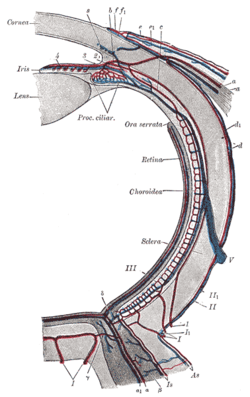| Vorticose veins | |
|---|---|
 The veins of the choroid. (Venae vorticosae labeled - though difficult to see - at center.) | |
 Diagram of the blood vessels of the eye, as seen in a horizontal section. ("V", at center right, is the label for the vena vorticosa) | |
| Details | |
| Drains to | Superior ophthalmic vein, and inferior ophthalmic vein |
| Artery | short posterior ciliary arteries[citation needed] |
| Identifiers | |
| Latin | venae vorticosae |
| TA98 | A12.3.06.106 |
| TA2 | 4892 |
| FMA | 70880 |
| Anatomical terminology | |
The vorticose veins, referred to clinically as the vortex veins,[1] are veins that drain the choroid of the eye. There are usually 4-5 vorticose veins in each eye, with at least one vorticose vein per each quadrant of the eye. Vorticose veins drain into the superior ophthalmic vein, and inferior ophthalmic vein.[2]
Vorticose veins are an important ophthalmoscopic landmark.[3]
YouTube Encyclopedic
-
1/5Views:187 96017 2372 566430892
-
Eyeball | Blood Supply
-
Blood Supply of the Eye (Ophthalmic Artery & Vein) - Anatomy
-
Somso Eye Model
-
Nerves & vessels of orbit (Eye 5)
-
Eyeball Anatomy
Transcription
Structure
Course and relations
Vorticose veins exit the eyeball 6 mm posterior to its equator.[2]
Fate
Upper vortex veins empty into the superior ophthalmic vein, and lower vortex veins empty into the inferior ophthalmic vein.[2][4]
Variation
The number of vorticose veins is known to vary from 4 to 8, with about 65% of the normal population having 4 or 5[1] with at least one vein in each quadrant.[2]
Clinical significance
Vorticose veins are an important ophthalmoscopic landmark.[3] They can be visualised in a dilated pupil using an indirect ophthalmoscope.[2]
Additional images
-
The blood-vessels of the eyeball (diagrammatic).
References
- ^ a b Kutoglu, Tunc; Yalcin, Bulent; Kocabiyik, Necdet; Ozan, Hasan (2005). "Vortex veins: Anatomic investigations on human eyes". Clinical Anatomy. 18 (4): 269–273. doi:10.1002/ca.20092. PMID 15832350. S2CID 42756249.
- ^ a b c d e Remington, Lee Ann (2012). "Orbital Blood Supply". Clinical Anatomy and Physiology of the Visual System. Elsevier. pp. 202–217. doi:10.1016/b978-1-4377-1926-0.10011-6. ISBN 978-1-4377-1926-0.
- ^ a b Potter, J. W.; Vandervort, R. S.; Thallemer, J. M. (November 1984). "The clinical significance of the vortex veins". Journal of the American Optometric Association. 55 (11): 822–824. ISSN 0003-0244. PMID 6512144.
- ^ Standring, Susan (2020). Gray's Anatomy: The Anatomical Basis of Clinical Practice (42nd ed.). New York. p. 780. ISBN 978-0-7020-7707-4. OCLC 1201341621.
{{cite book}}: CS1 maint: location missing publisher (link)
External links

